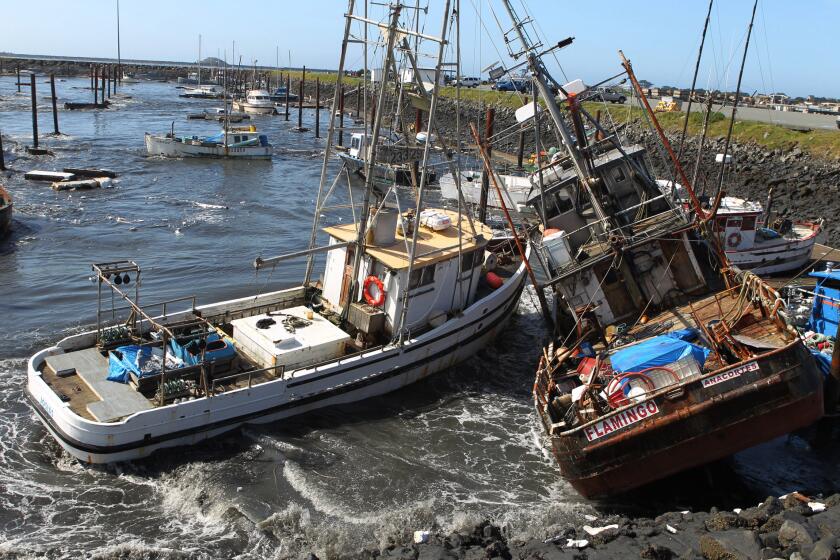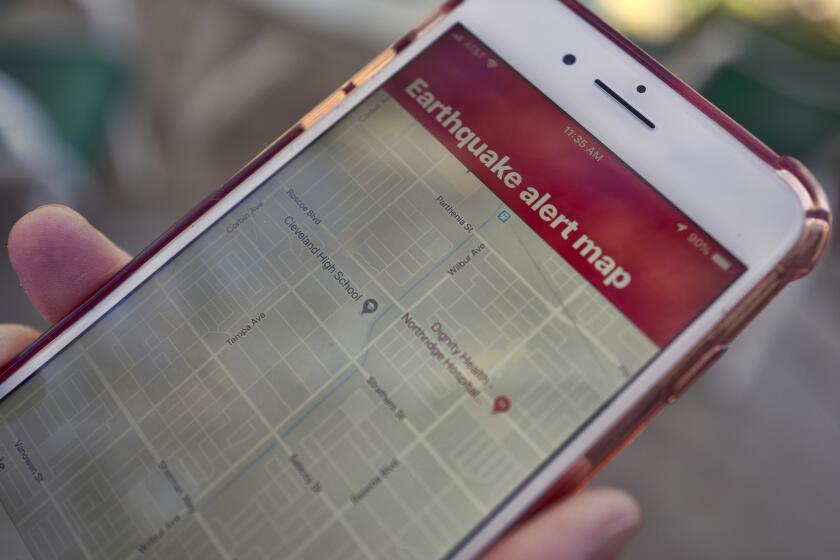After the Quake : Pasadena: City Spared the Worst, but Old Town Trembles
- Share via
Joy Taylor, the owner of a chic hair salon in Old Pasadena, cast a wary eye toward a cracked archway of brick and wood about 10 feet above her head and sighed in frustration.
Since last Thursday’s quake, the turn-of-the-century archway has survived dozens of aftershocks rippling through the area, but it has also been visibly weakened, littering the carpet below with shards of brick and mortar.
“Every time there is a tremor, the walls move a little more,” Taylor said. “It’s just scary to be in here.”
Her business, Biro’s Salon, was closed following the quake, and she estimates that she is losing up to $1,200 a day.
“We’ve only been in business for seven weeks,” she said. “Things were just getting settled and then this happens.”
But compared to those closer to the quake’s epicenter, who saw their homes and businesses crumble into dust, Taylor and others in Pasadena fared relatively well.
Only one building in the city was destroyed--an aging brick structure on Fair Oaks Avenue that housed Fair Oaks Automotive. Damage elsewhere was confined primarily to cracked plaster and toppled chimneys.
According to Tom Wilkens, senior administrative analyst with the city’s Planning, Housing and Development Services Department, total damage in the city could be anywhere from $500,000 to $1.5 million.
“This is mild,” he said. “It’s nothing.”
Wilkens cautioned that his rough estimate could climb as structural engineers complete their analysis of damaged buildings.
But he said he doubted that the damage would be anywhere near the amount sustained in cities such as Whittier.
The hardest-hit area in the city was Old Pasadena, 11 square blocks of turn-of-the-century buildings that served as Pasadena’s downtown during its golden years as a resort for the rich and famous.
In the first moments of the quake, the Fair Oaks Automotive building collapsed in a cloud of dust, nearly burying the mechanics inside.
Over the next few days, city building inspectors closed a dozen other businesses as a precaution because of ominous-looking cracks or buckling walls.
Rosicler’s, a restaurant on Colorado Boulevard owned by Sammy Zaribaf, was closed for a day as structural engineers inspected the building.
Zaribaf had been planning to open a new wing in his restaurant, hopeful that after years of waiting for the redevelopment of Old Pasadena, his business was set to take off.
He said that the city allowed him to reopen Friday afternoon and that by Sunday, business was back to normal.
“It was like nothing had ever happened,” Zaribaf said. “I lost only one bottle of wine. Thank God it was a cheap one.”
The focus of concern in Old Pasadena was a square block of vacant buildings at the intersection of Colorado Boulevard and Fair Oaks Avenue that developer John Patrick Wilson and the CMC Development Corp. hope to turn into a upscale $75-million urban mall called the Pasadena Marketplace.
Bruce Phillips, CMC vice president in charge of the project, said most of the buildings sustained only minor damage such as cracked plaster and toppled bricks.
But the front facades on a row of buildings on Fair Oaks buckled during the quake and will require extensive work to brace them. None of the walls have come down, but they are visibly weaker, and most of the area has been cordoned off.
“It’s not going to take much of a shake for this to come down,” Phillips said as he surveyed the damage this week.
Phillips said he hopes to have the buildings repaired in a month. The total cost will be about $100,000, he estimated.
Despite the damage, Phillips said he was elated that most of the Marketplace survived intact.
Last month, the roof of one corner building collapsed, spilling hundreds of bricks onto the pavement below. Surprisingly, there was no further damage to the building from Thursday’s quake or the aftershocks.
“We came through surprisingly well, given the level of the tremors,” he said.
Outside Old Pasadena, damage to homes and businesses was also surprisingly light.
New Cracks Reported
Many residents reported new cracks in their buildings, but other than that, the only major damage was toppled chimneys.
Wilkens said city inspectors went to about 400 homes that had chimney problems, but he added that many more probably went unreported.
For many homeowners, the loss was bearable.
“I feel lucky, I guess,” said Kent Howard, who lost a chimney but suffered no other damage. “At least now I feel confident about the strength of my house.”
Several old buildings that have been considered vulnerable to damage from a major quake, including the Huntington Sheraton Hotel, the downtown YMCA, City Hall and the Rose Bowl, also weathered the tremors with little damage.
One exception was the Colorado Street Bridge, which was closed by the city Sunday because of possible quake damage.
Chunks of concrete were scattered on the ground below the 74-year-old bridge. Mitsugi Hino, a city engineer, said he was uncertain whether there was more severe structural damage.
County inspectors looked over the bridge Wednesday. A final decision on whether to reopen it is expected within four weeks, Hino said.
Emergency Plans Tested
The earthquake was a test of the city’s emergency procedures, and by most reports, they passed with no problem.
Wilkens reported only two quake-related fires in the city. Both were extinguished before any major damage occurred, he said. Total fire damage was estimated at $30,000.
The school district had few problems, in part because Pasadena High School was the only school in the district that had started classes when the quake hit.
“Everything went really good,” said Charles Parcell, the district’s director of safety and security. “Everybody invoked the emergency plan just beautifully.”
At Pasadena High, junior Kendall Perkins said he had just taken a seat in his history class when the first tremors hit.
Except for some yelling from nearby classrooms, students seemed to take the quake in stride, he said.
“We all went under our desks without anyone saying it,” Perkins said. “Everything went pretty clean.”
Under the Desk
He said he stayed under his desk for about a minute before the evacuation alarm went off. Then he left with his classmates.
“We have earthquake drills every month, and that really paid off,” said Principal E. Louise Coover.
In the aftermath of the quake, Coover said the school has changed a few evacuation routes and expanded an emergency medical team.
Otherwise, she said, the school’s existing evacuation plans seemed to work well.
“I thought a lot of people would be jumping off the second floor and going crazy, but it was no problem,” Perkins said.
More to Read
Sign up for Essential California
The most important California stories and recommendations in your inbox every morning.
You may occasionally receive promotional content from the Los Angeles Times.











